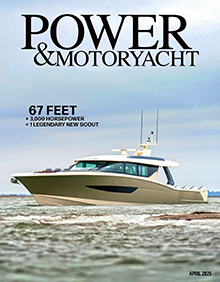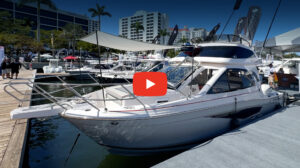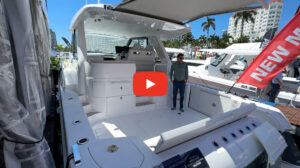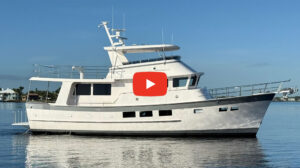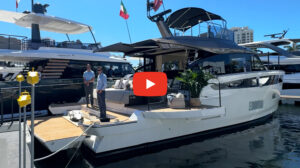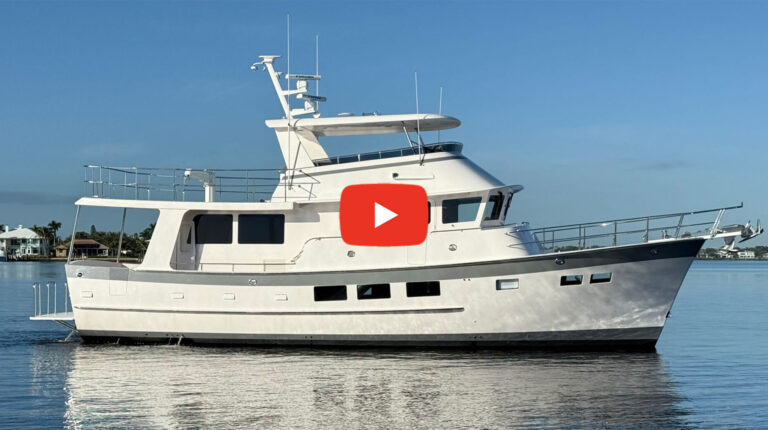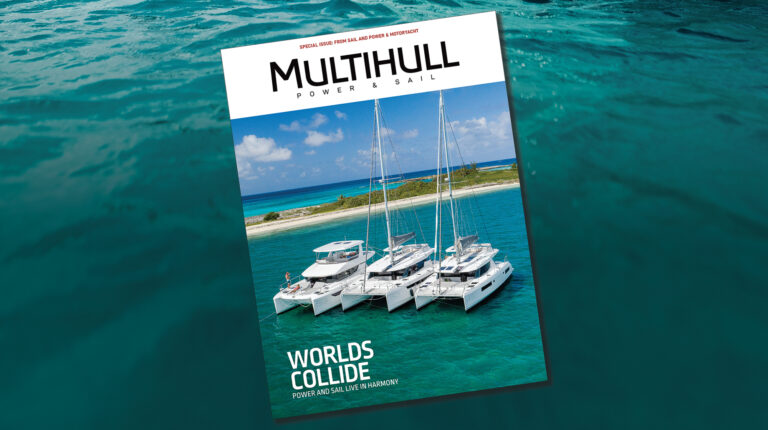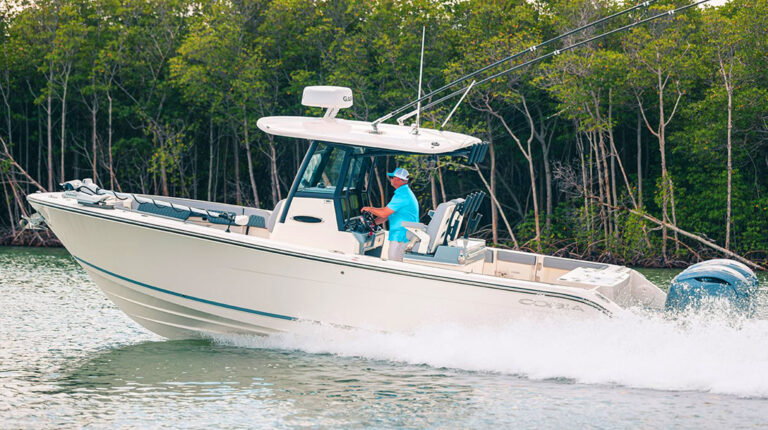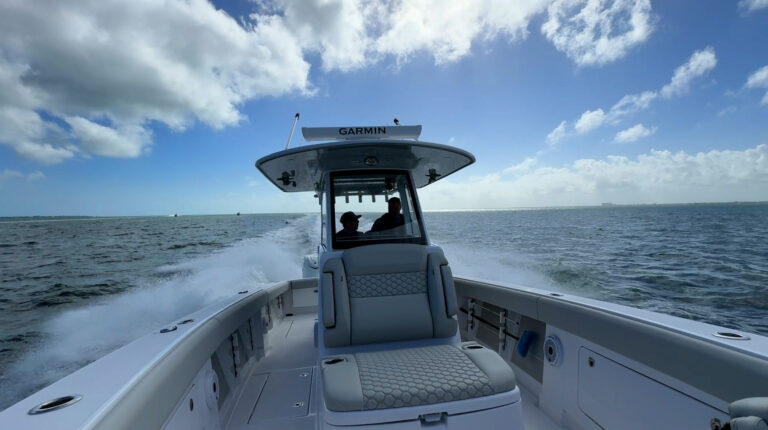
King of Composites
Goetz Composites looks to new technology and a range of new ventures to stay in the boatbuilding game
Photos by Randee Post Daddona
On a map, the town of Bristol, Rhode Island, resembles a prehistoric bird claw, the famed Narragansett Bay the waters in which the peninsula dips its talons. Like Rhode Island’s other maritime towns, Bristol is quiet and kempt, and time seems to unfold slowly here, especially when boats tuck themselves in for the winter months. In the years since the Great Recession though, the maritime and boatbuilding industries have suffered a similar quiet disappearance, and in a town that once produced legions of America’s Cup prototypes through most of the 20th century, adaptation has had to come quickly.
Innovation has arrived in the form of composites, a term for the process by which two or more natural or artificial elements (with different physical or chemical properties) are combined to produce a material more reliable than each of the materials on their own. They run the gamut from fiberglass to polyester to prepreg carbon, all of which are responsible for creating some of the world’s fastest and most structurally sound boats. And in Bristol, composite companies have thrived due to their ability to simultaneously pivot to other areas of business—from architecture to construction to, most surprisingly, amusement parks.

Situated in the middle of this vibrant industry is Goetz Composites—its offices are smack in the middle of the peninsula—which has resurfaced as a leader in specialized projects following its bankruptcy during the Great Recession. “We crashed because we couldn’t sell another boat,” Eric Goetz, 70, founder and Chief Technology Officer, told me. “By 2010, nobody was buying boats. Rich guys were still rich but were feeling the pinch, and they just weren’t buying custom boats. So the question we asked ourselves was, ‘How do you get a job?’ You create the job.”
By that time Goetz had slashed his workforce to three employees, at which point he realized that what he was selling wasn’t boatbuilding so much as composite expertise. If boats are essentially sculptural shapes, Eric wondered, couldn’t that process of combining skins (carbon, fiberglass, Kevlar, etc.) with core materials (honeycomb, foam core, etc.) apply to other projects as well? Soon enough, New York City commissioned Goetz to create a weather vane for the Staten Island Children’s Museum, and Brown University hired them to build custom-made furniture for a building on their campus. Steadily, Goetz was able to regrow his staff to about 50 employees, just over half of what it had been at its peak in the early 2000s. For a company that once built 10 America’s Cup racing boats, this transition proved successful due to the trustworthy roster of talent that Goetz employs.
Gary Wolfang, for example, has been employed as a senior member by Goetz since 1985 and was one of the three remaining employees when the company had to scale back in 2009. Gary has completed thousands of projects during his long tenure (“We’d start from a piece of paper to a party at the end”) but chief among his talents—integral to past and future employees for that matter—is his adherence to the privacy and discretions of the clients.


This is no small task. As one of several composite companies operating in Bristol, not to mention the rest of Rhode Island, it would seem only natural for Goetz to show off their myriad works. Walking in Bristol and the nearby coastal towns of Providence and Narragansett, one experiences a rush in what boat makers and other purveyors are creating and brandishing; it is competition at its healthiest, a sensory-induced boon to the resplendent location.
But walking on Goetz’s campus, not so much a bustling warehouse as it is a series of several mobile trailers located inside a vacuous garage, one gawks at the number of projects that are proprietary, shut away from the public. Part of this secrecy is the preservation of their clients’ anonymity, especially since some of the projects they commission are exclusive to their outsized ambitions or preferences. “The doctors and lawyers can’t afford our boats any longer. The guys who are buying them are industrialists, big-time businesspeople,” said Goetz. He doesn’t mean this as a brag; Goetz is too mild-mannered and soft-spoken. He simply means that given the changes to the industry, his company has had to re-focus its attention on custom works that will warrant the research and development they inevitably incur—that will bridge both the past and the future.
One such project is the Red Foiling Boat, a 36-foot carbon fiber catamaran that was completed for a private customer in the summer of 2019. Foiling—which involves raising a boat on hydrofoils so that it appears to be hovering above the water, therefore reducing drag—is not a new concept, but Goetz has made it possible for this boat to achieve high speed and long range, among the fastest of its kind. “There isn’t anything like it on the market,” Goetz said. “Not only did the customer want this boat, but he also—being a very, very tech-savvy guy—funded the building and development of it.” Goetz said the owner funded the test program and software the boat uses to “fly”; the foiling boat features a fly-by-wire throttle at the wheel that is controlled by a computer program, similar to the software in flight control systems used by modern airfare. The process required collaboration and work with various sub-contractors, including America’s Cup designers Dirk Kramers and Steve Koopman and the Woods Hole Oceanographic Institution.
“What’s happening lately is this whole push to foiling, whether it’s powerboats or sailboats. It’s everywhere,” said Koopman, who runs SDK in nearby Tiverton. “It seems like anyone who has a boat now wants to put it up on foils.”
The last few iterations of America’s Cup racing boats have featured foils, despite regulatory moves taken by Oracle when it hosted the games in San Francisco to limit these innovations. “Once the New Zealand team found a way around these limits,” said Koopman, “pretty much everyone after that had to follow suit.”
Koopman told me that he has been approached by powerboat manufacturers interested in taking standard 40-foot cruisers and putting them on foils. Though there are challenges to making that process affordable, Koopman thinks there is a vibrant future.
Similarly, Goetz sees a more immediate application for foiling in tenders to superyachts. Since the Red Foiling Boat achieves a high payload capacity (2,200 pounds to be exact), Goetz began to think about smaller, more maneuverable methods. “If you have your 250-foot powerboat and you need a tender, foiling would be ideal for many reasons,” he said. “First of all, if you want to take your guests ashore for the evening, you just fly them ashore. Or if you want to take them to the middle of the ocean for scuba diving, you have the payload to pack on people and scuba gear.”
Though access to larger-scale projects is not imminent, the average—or as Goetz puts it, the normal customer—does have access to Goetz’s handiwork. He has created flybridges and custom swim platforms for Hinckley’s 55- and 48-foot Talaria models, a partnership that has existed for years. And for Outer Limits, a high-end production builder, Goetz is in the process of designing a hull mold. Outer Limits, also located in Bristol, is unique due to their introduction of high-functioning tech to high-speed powerboats. The 36-footer Goetz and Outer Limits are working on will be able to go anywhere from 80 to 100 mph. “Outer Limits recognized that they had to keep their customers safe,” Goetz said, “so they needed to use higher-end materials. And since they are about speed, they needed to keep the weight down.” That’s where Goetz came in, providing the composite materials to create and laminate the hull that will one day grace the waters of Rhode Island and beyond. Outer Limits plans to have this first high-speed boat in the water by Spring 2020.
If foiling is the future, sailing remains Goetz’s past. Before he was a renowned builder and business owner, he took up professional sailing after graduating from Brown University with a degree in anthropology. Today, operating in his warehouse, wherein machines pulse and hum to instructions set by diagrams on paper, it is easy to feel disconnected from the water. And given the ceaseless construction of disconnected projects—from foiling to part-making to amusement park additions (the latter of which cannot be talked about, Goetz informed me), one may overlook the fact that, ultimately, Goetz Composites’ legacy begins, and will end, with sailing.
When he was a young boy and sailing with his family in Manhasset Bay, on the north shore of Long Island, the boat he was in capsized, leaving him and his family stranded. They weren’t out at sea long, but it was a scary moment for the then-10-year-old. Goetz viewed this as a formative experience, one that got him interested in the process of perfecting boats. There will always be a next time, he told himself, and next time will be better.

